
Arkanoid is a 1986 block breaker arcade game developed and published by Taito. In North America, it was published by Romstar. Controlling a paddle-like craft known as the Vaus, the player is tasked with clearing a formation of colorful blocks by deflecting a ball towards it without letting the ball leave the bottom edge of the playfield. Some blocks contain power-ups that have various effects, such as increasing the length of the Vaus, creating several additional balls, or equipping the Vaus with cannons. Other blocks may be indestructible or require multiple hits to break.

Athena is a platform arcade game, developed and published in 1986 by SNK. Conversions were later released for the NES console and ZX Spectrum and Commodore 64 home computers.
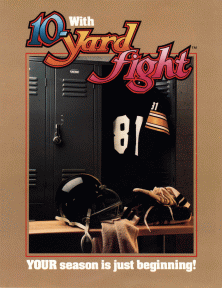
10-Yard Fight is an American football sports video game that was developed and published in Japan by Irem for arcades in 1983. It was published overseas by Taito in the Americas, by Electrocoin in Europe, and by ADP Automaten GmbH in West Germany.
A sports video game is a video game that simulates the practice of sports. Most sports have been recreated with a video games, including team sports, track and field, extreme sports, and combat sports. Some games emphasize actually playing the sport, whilst others emphasize strategy and sport management. Some, such as Need for Speed, Arch Rivals and Punch-Out!!, satirize the sport for comic effect. This genre has been popular throughout the history of video games and is competitive, just like real-world sports. A number of game series feature the names and characteristics of real teams and players, and are updated annually to reflect real-world changes. The sports genre is one of the oldest genres in gaming history.
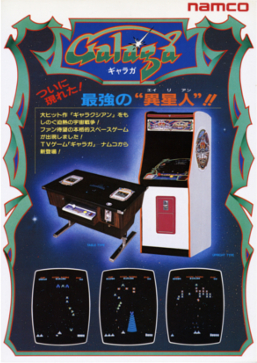
Galaga is a 1981 fixed shooter arcade video game developed and published by Namco. In North America, it was released by Midway Manufacturing. It is the sequel to Galaxian (1979), Namco's first major video game hit in arcades. Controlling a starship, the player is tasked with destroying the Galaga forces in each stage while avoiding enemies and projectiles. Some enemies can capture a player's ship via a tractor beam, which can be rescued to transform the player into a "dual fighter" with additional firepower.

Ikari Warriors, known as Ikari in Japan, is a vertically scrolling run and gun video game released for arcades by SNK in 1986. It was published in North America by Tradewest. At the time there were many Commando clones on the market. What distinguished Ikari Warriors were rotary joysticks and a two-player cooperative mode. The rotary joystick controls were in turn based on SNK's earlier TNK III (1985). Ikari was originally intended to be an official licensed adaptation of the film Rambo: First Blood Part II (1985), but SNK were initially unable to acquire the rights to the film.

The Nintendo VS. System is an arcade system developed and produced by Nintendo from 1984 to 1990. It is based on most of the same hardware as the Family Computer (Famicom), later released as the Nintendo Entertainment System (NES). Most of its games are conversions from the Famicom and NES, some heavily altered for the arcade format, and some debuted on the VS. System before being released on the Famicom or NES. The system focuses on two-player cooperative play. It was released in three different configurations: upright VS. UniSystem cabinets, upright VS. DualSystem cabinets, and sit-down VS. DualSystem cabinets. Games are on pluggable circuit boards, allowing for each side to have a different game.

Super Sprint is a racing video game released by Atari Games and Midway Games in 1986. Up to three players drive Formula One-like cars on a circuit that is viewed from above. The game is a successor to Gran Trak 10 and the Sprint series, which were black-and-white games from the 1970s. A sequel, Championship Sprint, was released later in the same year.

Sengoku is a beat 'em up arcade game. It is the first entry of the Sengoku trilogy by SNK. It was ported to numerous home consoles including the Neo Geo, Neo Geo CD, Mega-CD and Super Famicom. The arcade version was part of SNK Arcade Classics Vol. 1, released in 2008. The Neo Geo version was re-released on the Japanese Virtual Console in 2011, with the sequels for the North American Virtual Console on November 8, 2012 and June 6, 2013 and for the PAL region on February 7, 2013 and September 5, 2013. In 2009 the series was compiled on the Sengoku Anthology for PlayStation 2 and Windows.
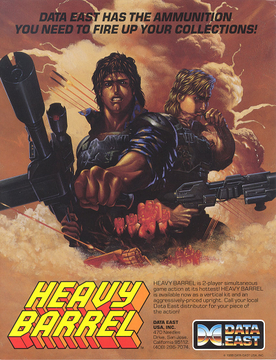
Heavy Barrel is a 1987 overhead run and gun arcade game by Data East.

Ikari III: The Rescue, simply known as Ikari III (怒III) in Japan, is a 1989 arcade run & gun shoot 'em up game developed and published by SNK. It was ported to the NES, IBM PC compatibles, and Commodore 64. It is the third and final installment of the Ikari Warriors series after Ikari Warriors and Victory Road. The NES version was shown at the 1991 CES.

Guerrilla War, released in Japan as Guevara (ゲバラ), is an overhead run and gun video game produced by SNK. Originally released for arcades in 1987 as a coin-operated arcade game, Guerrilla War was ported to Amstrad CPC, Apple II, Commodore 64, Nintendo Entertainment System, PlayStation Network, and ZX Spectrum.

Alpha Mission, known as ASO: Armored Scrum Object in Japan, is a vertically scrolling shooter developed by SNK and released as an arcade video game in 1985 by Namco in Japan and Tradewest in North America. It was later ported to the Famicom in 1986 and released for the Nintendo Entertainment System in 1987.

Time Soldiers, known in Japan as Battle Field, is a 1987 run and gun video game developed by Alpha Denshi for arcades and published by SNK. It was distributed in North America by Romstar. A Master System version was also produced, as well as versions titled Time Soldier for the Amiga, Commodore 64, and Atari ST.

Puzz Loop is an arcade tile-matching puzzle game developed by Mitchell Corporation and released in 1998 for Japan and North America and 1999 for Europe. It was later ported to the Game Boy Color, PlayStation and Samsung Nuon DVD players under the name Ballistic. The original Puzz Loop game was also known by this title. In 2008, publisher Hudson Soft released the game on App Store for the iPhone and iPod Touch. There was a Neo Geo Pocket Color version of the game initially planned to be published by SNK, but cancelled due to bankruptcy of the original incarnation of the company.

Mechanized Attack is a shooter game developed and published by SNK. It was released in North America for the arcade in 1989, and it was ported to the Nintendo Entertainment System in 1990. It can be played with either the NES controller or the NES Zapper light gun.

Syougi no Tatsujin is a board arcade video game developed by ADK and originally published by SNK on September 28, 1995, before being ported to the Neo Geo CD the same year. It was ported in a scaled-down version to the Neo Geo Pocket and later given improved graphics on the Neo Geo Pocket Color. It was only released in Japan.

T.A.N.K. is a vertically scrolling multidirectional shooter developed and released in arcades by SNK 1985. It was published in North America as TNK III by Kitcorp. Versions of T.A.N.K. for home computers were released by Ocean Software for the ZX Spectrum, Commodore 64, and Amstrad CPC in 1987. A sequel was also released for the Nintendo Entertainment System titled Iron Tank.
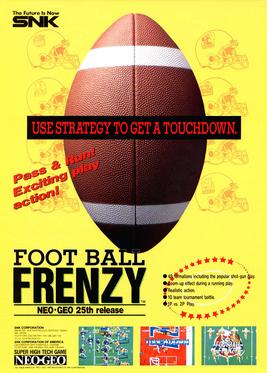
Football Frenzy is an American football arcade video game developed and originally published by SNK on January 31, 1992. It was the second football game created by SNK after 1987's Touch Down Fever, as well as the only football game released for the Neo Geo platform.
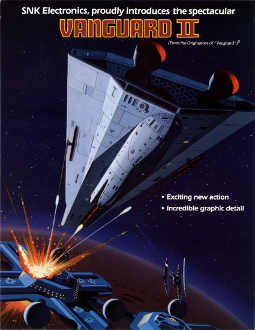
Vanguard II is a multidirectional shooter video game developed and published by SNK released in arcades in 1984. It is the sequel to the 1981 game Vanguard. It was not as successful as the original.


















